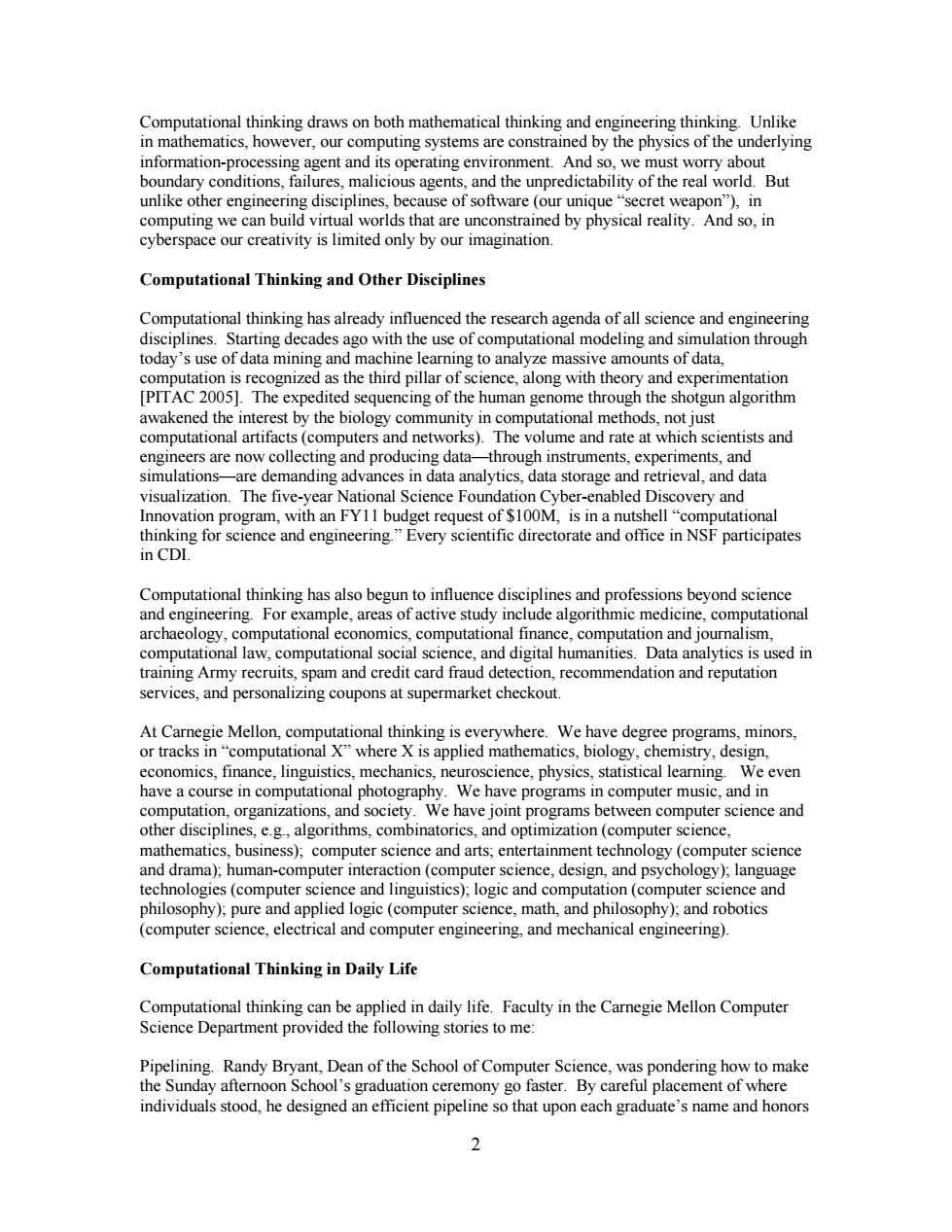正在加载图片...

Computational thinking draws on both mathematical thinking and engineering thinking.Unlike in mathematics,however,our computing systems are constrained by the physics of the underlying information-processing agent and its operating environment.And so,we must worry about boundary conditions,failures,malicious agents,and the unpredictability of the real world.But unlike other engineering disciplines,because of software (our unique "secret weapon"),in computing we can build virtual worlds that are unconstrained by physical reality.And so,in cyberspace our creativity is limited only by our imagination. Computational Thinking and Other Disciplines Computational thinking has already influenced the research agenda of all science and engineering disciplines.Starting decades ago with the use of computational modeling and simulation through today's use of data mining and machine learning to analyze massive amounts of data, computation is recognized as the third pillar of science,along with theory and experimentation [PITAC 2005].The expedited sequencing of the human genome through the shotgun algorithm awakened the interest by the biology community in computational methods,not just computational artifacts(computers and networks).The volume and rate at which scientists and engineers are now collecting and producing data-through instruments,experiments,and simulations-are demanding advances in data analytics,data storage and retrieval,and data visualization.The five-year National Science Foundation Cyber-enabled Discovery and Innovation program,with an FY11 budget request of $100M,is in a nutshell"computational thinking for science and engineering."Every scientific directorate and office in NSF participates in CDI. Computational thinking has also begun to influence disciplines and professions beyond science and engineering.For example,areas of active study include algorithmic medicine,computational archaeology,computational economics,computational finance,computation and journalism, computational law,computational social science,and digital humanities.Data analytics is used in training Army recruits,spam and credit card fraud detection,recommendation and reputation services,and personalizing coupons at supermarket checkout. At Carnegie Mellon,computational thinking is everywhere.We have degree programs,minors, or tracks in"computational X"where X is applied mathematics,biology,chemistry,design, economics,finance,linguistics,mechanics,neuroscience,physics,statistical learning.We even have a course in computational photography.We have programs in computer music,and in computation,organizations,and society.We have joint programs between computer science and other disciplines,e.g.,algorithms,combinatorics,and optimization (computer science, mathematics,business);computer science and arts;entertainment technology (computer science and drama);human-computer interaction(computer science,design,and psychology);language technologies (computer science and linguistics);logic and computation(computer science and philosophy);pure and applied logic(computer science,math,and philosophy);and robotics (computer science,electrical and computer engineering,and mechanical engineering). Computational Thinking in Daily Life Computational thinking can be applied in daily life.Faculty in the Carnegie Mellon Computer Science Department provided the following stories to me: Pipelining.Randy Bryant,Dean of the School of Computer Science,was pondering how to make the Sunday afternoon School's graduation ceremony go faster.By careful placement of where individuals stood,he designed an efficient pipeline so that upon each graduate's name and honors 22 Computational thinking draws on both mathematical thinking and engineering thinking. Unlike in mathematics, however, our computing systems are constrained by the physics of the underlying information-processing agent and its operating environment. And so, we must worry about boundary conditions, failures, malicious agents, and the unpredictability of the real world. But unlike other engineering disciplines, because of software (our unique “secret weapon”), in computing we can build virtual worlds that are unconstrained by physical reality. And so, in cyberspace our creativity is limited only by our imagination. Computational Thinking and Other Disciplines Computational thinking has already influenced the research agenda of all science and engineering disciplines. Starting decades ago with the use of computational modeling and simulation through today’s use of data mining and machine learning to analyze massive amounts of data, computation is recognized as the third pillar of science, along with theory and experimentation [PITAC 2005]. The expedited sequencing of the human genome through the shotgun algorithm awakened the interest by the biology community in computational methods, not just computational artifacts (computers and networks). The volume and rate at which scientists and engineers are now collecting and producing data—through instruments, experiments, and simulations—are demanding advances in data analytics, data storage and retrieval, and data visualization. The five-year National Science Foundation Cyber-enabled Discovery and Innovation program, with an FY11 budget request of $100M, is in a nutshell “computational thinking for science and engineering.” Every scientific directorate and office in NSF participates in CDI. Computational thinking has also begun to influence disciplines and professions beyond science and engineering. For example, areas of active study include algorithmic medicine, computational archaeology, computational economics, computational finance, computation and journalism, computational law, computational social science, and digital humanities. Data analytics is used in training Army recruits, spam and credit card fraud detection, recommendation and reputation services, and personalizing coupons at supermarket checkout. At Carnegie Mellon, computational thinking is everywhere. We have degree programs, minors, or tracks in “computational X” where X is applied mathematics, biology, chemistry, design, economics, finance, linguistics, mechanics, neuroscience, physics, statistical learning. We even have a course in computational photography. We have programs in computer music, and in computation, organizations, and society. We have joint programs between computer science and other disciplines, e.g., algorithms, combinatorics, and optimization (computer science, mathematics, business); computer science and arts; entertainment technology (computer science and drama); human-computer interaction (computer science, design, and psychology); language technologies (computer science and linguistics); logic and computation (computer science and philosophy); pure and applied logic (computer science, math, and philosophy); and robotics (computer science, electrical and computer engineering, and mechanical engineering). Computational Thinking in Daily Life Computational thinking can be applied in daily life. Faculty in the Carnegie Mellon Computer Science Department provided the following stories to me: Pipelining. Randy Bryant, Dean of the School of Computer Science, was pondering how to make the Sunday afternoon School’s graduation ceremony go faster. By careful placement of where individuals stood, he designed an efficient pipeline so that upon each graduate’s name and honors